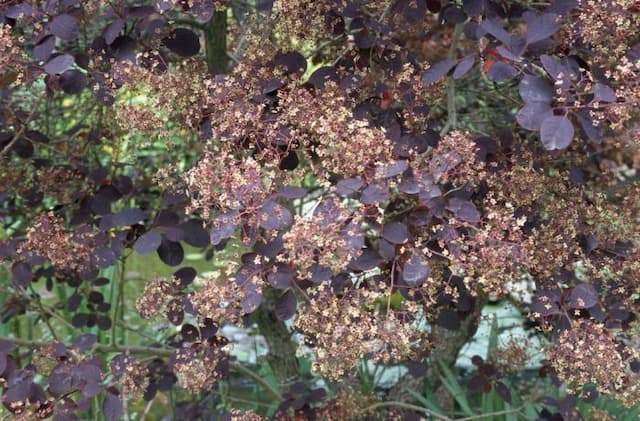Rhus potaninii Potanin's sumac
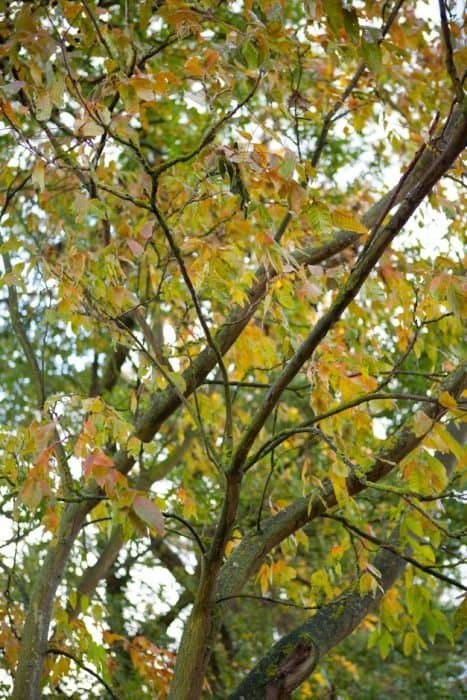
ABOUT
. Rhus potaninii is a deciduous shrub native to northeastern Asia. It typically grows in an upright, vase-shaped form to a height of 6 to 8 feet and a width of 4 to 5 feet. The branches are medium-textured and woody and may be slightly purple in color. The leaves are compound and bright green, with 7–13 leaflets and an alternate arrangement. The leaflets are ovate and smooth, with finely toothed margins, and measure up to 2 inches in length. The flowers are small, yellow-green, and arranged in dense clusters. When they bloom in early summer, they are followed by small, dark red fruits, which will persist into autumn. The fruits are ¼-inch in diameter and have a single seed inside.
About this plant
 Names
NamesFamily
Anacardiaceae
 Toxicity
ToxicityTo humans
of the plant, and do not mention other species of Rhus. Rhus potaninii, also known as Japanese lacquer tree, is a toxic plant for humans. Consumption of the plant can lead to severe toxicity and cause vomiting, abdominal pain, dizziness and collapse. In some cases, it can also lead to coma and death. Atropine like alkaloids found in the plant can cause damage to the heart, liver, and kidneys and lead to long-term health consequences. Contact with the plant's sap can cause skin irritation and dermatitis.
To pets
of Rhus potaninii. Rhus potaninii is a poisonous plant and can be toxic to livestock and other grazing animals. Consumption of the plant can result in a condition known as "Poisoning of Red Deckers" which is characterized by abdominal pain, diarrhea, vomiting, tachycardia, dermatitis, oedema, photophobia and blood in the urine. Symptoms may be severe and can even lead to death.
Benefits
 General Benefits
General Benefits- Improves Air Quality - Rhus potaninii is known to help reduce air pollution by absorbing excess carbon dioxide and releasing oxygen.
- Attracts Wildlife - Its dense canopy and dense foliage provide shelter and food for a variety of animals and birds.
- Promotes Healthy Soil - Its deep root system helps to loosen compacted soil, improving water infiltration and aeration.
- Drought Tolerance - Rhus potaninii is a hardy and drought-tolerant species that can thrive in dry conditions.
- Reduces Erosion - Its strong root system helps to protect soil from erosion, wind and water damage.
- Increases Aesthetic Appeal - Its attractive foliage and flowers make it a great addition to any garden or landscape.
 Medical Properties
Medical Properties1. Analgesic: Rhus potaninii has been found to possess analgesic properties, which can help to reduce pain and inflammation. 2. Anti-inflammatory: Rhus potaninii has been shown to have powerful anti-inflammatory activity, which can help to reduce swelling and pain from inflammatory conditions. 3. Anti-pyretic: Rhus potaninii has been found to possess anti-pyretic activity, which can help to reduce fever and other symptoms associated with infection. 4. Antipruritic: Rhus potaninii has been found to possess a strong antipruritic effect, which can help to reduce itching and discomfort from certain skin disorders. 5. Antibacterial: Rhus potaninii has been found to have potent antibacterial properties, which can help to reduce the growth of bacteria and prevent infections. 6. Antifungal: Rhus potaninii has been found to possess antifungal properties, which can help to reduce the growth of fungi and prevent infection. 7. Immunomodulatory: Rhus potaninii has been found to possess immunomodulatory properties, which can help to improve the body’s overall immunity and reduce the risk of certain diseases. 8. Wound healing: Rhus potaninii has been shown to possess wound healing properties, which can help to reduce the healing time for wounds and promote faster recovery. 9. Gastrointestinal Health: Rhus potaninii has been found to possess beneficial effects on the gastrointestinal tract, which can help to improve digestive health and reduce digestive problems. 10. Cardiovascular Health: Rhus potaninii has been found to possess beneficial effects on the cardiovascular system, which can help to reduce the risk of certain heart-related diseases.
 Air-purifying Qualities
Air-purifying QualitiesThe Rhus potaninii plant is highly effective at purifying the air inside a space due to its properties as an air-purifying plant. It is known to absorb harmful volatile organic compounds (VOCs), including benzene, formaldehyde, and trichloroethylene, while absorbing the pollutants and releasing clean air. The plant is also an effective natural humidifier, providing natural humidity levels.
 Other Uses
Other Uses. 1. Shelter: Rhus potaninii is a great plant to use when building natural shelter. Its thick, thicket-like branches can provide protection from the elements and also block out any sightlines from afar. 2. Fencing: The branches of the Rhus potaninii can also be used to construct a makeshift fence to protect a small, enclosed area. 3. Cooking: The green fruits of the Rhus potaninii can be harvested and cooked over an open fire for a delicious, sweet treat. 4. Crafts and Art: The leaves and branches of the Rhus potaninii can be utilized to craft unique wreaths and ornaments, or be used as material for artwork. 5. Bedding: Piling the leaves of the Rhus potaninii can be an effective way to make a soft, comfortable bed. 6. Building: The sturdiness of the Rhus potaninii can be used to create a stable structure, such as a small bridge or ladder.
Interesting Facts
 Feng Shui
Feng Shuiin this answer Rhus potaninii can be used in Feng Shui to create a strong energy center in your home. To do this, it should be placed in the Wealth/Prosperity area of your house. In this area, the Rhus potaninii will help to promote wealth and abundance, along with good health and protection. Other uses of Rhus potaninii include placing it in the Career area of your home to help you gain recognition and success in your professional life, or the Authority area to increase influence and power.
 Zodiac Sign Compitability
Zodiac Sign CompitabilityRhus potaninii does not correspond to any sign of the zodiac in astrology. Astrology deals with personalities and behaviors, not plants. The best way to find a connection between Rhus potaninii and astrology would be to look for characteristics in Rhus potaninii that could be related to the traits of a particular zodiac sign. For example, the vibrant colors of Rhus potaninii's leaves could be associated with the energy and enthusiasm of Aries, the trailblazer of the zodiac.
 Plant Symbolism
Plant SymbolismRhus potaninii, commonly known as 'Manchurian Sumac', is a medium-sized deciduous tree native to East Asia. It features an upright, round-shaped crown and bright yellow-green leaves that turn brilliant shades of red and orange in the fall. The bark of this tree is dark gray and leathery, with a deeply furrowed or scaly texture. The small red berries of Rhus potaninii attract birds and other small wildlife. Symbolically, Rhus potaninii is associated with the cycle of life and death. Its bright yellow-green leaves symbolize new life and abundant growth while its brilliant fall colors indicate the end of one life cycle and the beginning of another. The leathery bark of this tree also carries symbolism, representing strength and endurance amidst the ever-changing cycles of life. Finally, the vibrant red berries of Rhus potaninii signify abundance and fertility.
 Water
WaterRhus potaninii, also known as Korean sumac, should be watered once or twice each week depending on the climate and season. The best way to water is to give the plant a deep, thorough soaking until the soil is saturated. Allow the soil to dry out nearly completely between waterings, as Rhus potaninii is native to dry climates and can suffer if kept too wet. During hot, dry weather, it may need more frequent watering. Rhus potaninii requires an average of 1 to 1.5 inches of water per week.
 Light
LightRhus potaninii thrives in full sun to part shade conditions with bright, indirect light. The best spot for this plant is an area with morning sun and afternoon shade or bright, filtered sunlight throughout the day.
 Temperature
TemperatureThe best lighting conditions for Rhus potaninii is at least 6 hours of direct sunlight each day. This should be supplemented with shade during the hottest hours of the day. For the best summer temperature conditions, the ideal range for Rhus potaninii is between 59-77°F (15-25°C). In the winter, the ideal range for this species is between 41-59°F (5-15°C).
 Pruning
PruningRhus potaninii should be pruned in late winter or early spring before new growth begins. The amount of pruning depends on the desired size and shape of the shrub. If a strong form and dense foliage is desired, prune the shrub heavily; remove at least one third of the foliage and the oldest, thickest stems. If the desired shape is open and loose, prune out only the old, dead stems and a few slender crossed ones. Avoid topping the plant with a flat surface.
 Soil
Soilinstructions Ingredients needed: 1. 3 parts peat moss 2. 3 parts plastic potting soil 3. 1 part perlite 4. 1 part horticultural sand Instructions: 1. Begin by combining the peat moss, plastic potting soil, perlite and horticultural sand together in a large bucket. 2. Thoroughly mix the ingredients to make sure they are evenly distributed. 3. Place the soil mixture into your pot or other planting vessel and gently tamp down. 4. Water the soil mix until it is evenly moist. 5. The soil pH should be slightly acidic, ranging within the range of 4.5 to 6.5. For best results, consider testing soil pH prior to use. 6. Plant your Rhus potaninii in the prepared soil mix and water to settle the soil around the roots.
 Repotting
RepottingNo, Rhus potaninii does not need to be repotted.
 Humidity & Misting
Humidity & MistingThe best humidity level for Rhus potaninii is between 40%-60%. To increase the humidity, mist the leaves with water several times a day, keep the plant near a humidifier, or place it on a tray of wet pebbles. To decrease the humidity, keep the plant away from air conditioners and radiators and ensure the soil isn’t overly wet.
 Suitable locations
Suitable locationsIndoor
Rhus potaninii prefers bright, indirect light, moist but well-drained soil, and temperatures between 65-75°F. The soil should also remain consistently moist, and should be fertilized with a balanced, water-soluble fertilizer every two weeks during the plant’s growing season (spring to early fall). Rhus potaninii can tolerate lower light levels but will not flower in dim conditions. When the plant is actively growing, it should be kept at a minimum of 6 feet away from any cold drafts and heated vents. During the winter months, Rhus potaninii should be placed in a cool area with temperatures between 45-55°F and kept away from major temperature fluctuations. The soil should remain barely moist during the winter months, with just enough water to keep the soil from drying out completely.
Outdoor
Rhus potaninii grows best in full sun to partial shade, in moist (but well drained) soil exposed to temperatures ranging from 40 to 85 degrees Fahrenheit. It prefers high humidity and occasionally moist soil. It also thrives in a location not too far from a source of water for irrigation, such as a pond, stream, or lake. Rhus potaninii prefers a soil pH range of 5.5 to 7.6 and does best when planted in a location that does not receive too much wind. It has an average growth rate, typically reaching a height of anywhere from 3 to 8 feet tall and a spread of up to 6 feet.
Hardiness zone
Plant Hardiness Zones.
 Life cycle
Life cycle. Rhus potaninii, commonly known as Korean burning bush or winged sumac, is a deciduous, shrub-like plant native to Eastern and Central Asia. It features large, velvety, light green leaves that turn a deep burgundy shade in the fall. In the summer, clusters of bright red berries form that persist into the fall and winter. Germination: When grown from seed, Rhus potaninii starts to germinate in the late spring when soil temperatures reach at least 70°F. Seedling: In its early stages of growth, Rhus potaninii forms a small, rounded shrub with an upright stature. The leaves are bright green and offset by red berries. Maturity: As Rhus potaninii continues to mature, its foliage darkens and becomes shaggy in its appearance. The shrub is typically 3-6 feet tall and 4-6 feet wide when fully mature. Reproduction: In the late summer, Rhus potaninii produces clusters of shiny, red berries. The berries persist throughout the winter, providing food for many wildlife species. Senescence: Rhus potaninii typically lives for 15-20 years. As the shrub ages, its leaves turn a deep burgundy shade in the fall and its growth rate slows. It can reach a height of up to 9 feet.
 Propogation
PropogationPropagation of Rhus potaninii can occur through stem cuttings or through division of a clump. Stem Cuttings: Rhus potaninii can be propagated through stem cuttings taken in late spring. Stems should be taken from the current or previous season's growth and trimmed to 3-4 inches in length. Under ideal conditions, the cuttings should form a callus within 2-3 weeks after being removed from the mother plant. The cuttings should then be individually potted up in a quality potting mix and placed in a unheated greenhouse (50-60°F) with bright, indirect light. Water the potting mix well and keep it evenly moist for the first month, after which the rooting process should be complete. The plants can then be fertilised every 6 weeks during spring and summer months. Clump Division: Rhus potaninii can also be propagated from division of an established clump. The clumps should be carefully dug up and divided into smaller sections when the soil is moist. Each portion should have a decent amount of roots attached to it and should then be individually potted up and placed in a unheated greenhouse (50-60°F) with bright, indirect light. As with the stem cuttings, the potting mix should be kept moist during the rooting process (approximately 2 weeks) and the plants should be fertilised every 6 weeks during the spring and summer months.
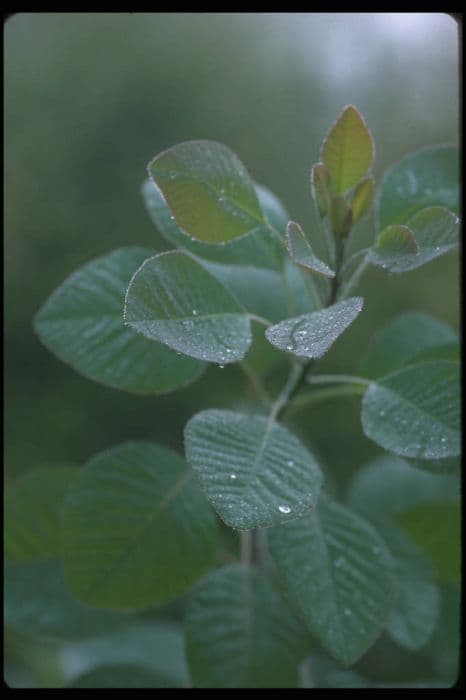
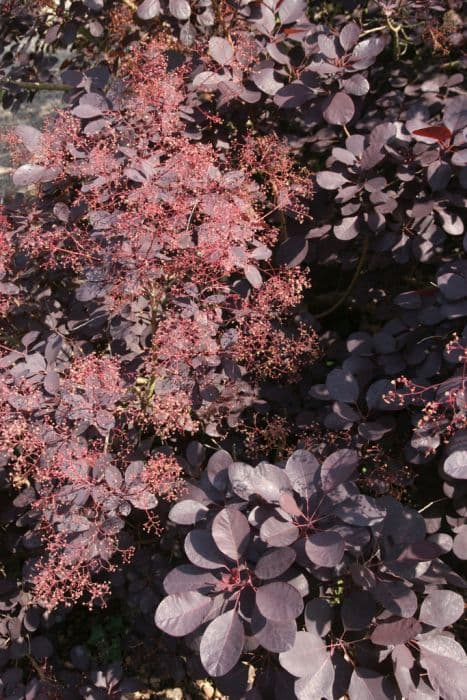
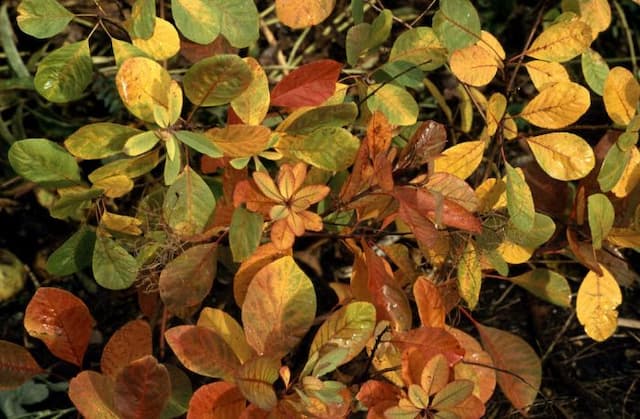
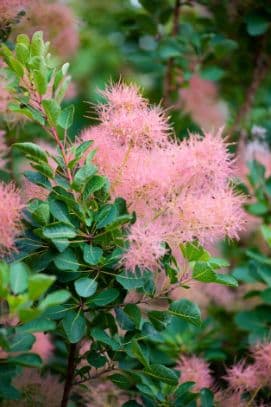
![Smoke tree [Golden Spirit]](/_next/image?url=https%3A%2F%2Fplants-admin.emdemapps.com%2Fimages%2Fplants%2F%2Fimages%2F604b63b450a12.png&w=640&q=75)
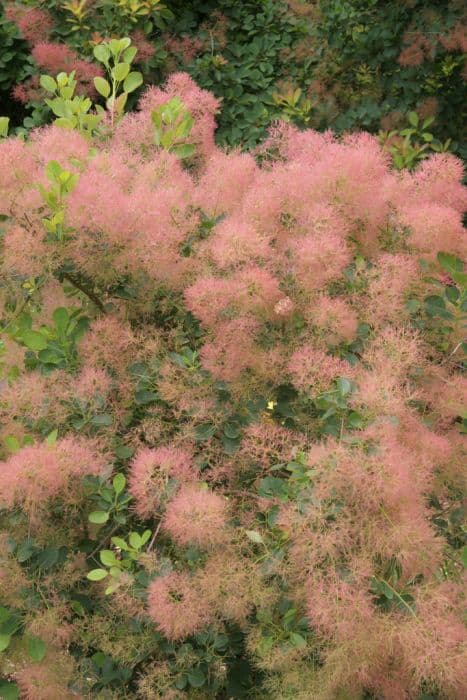

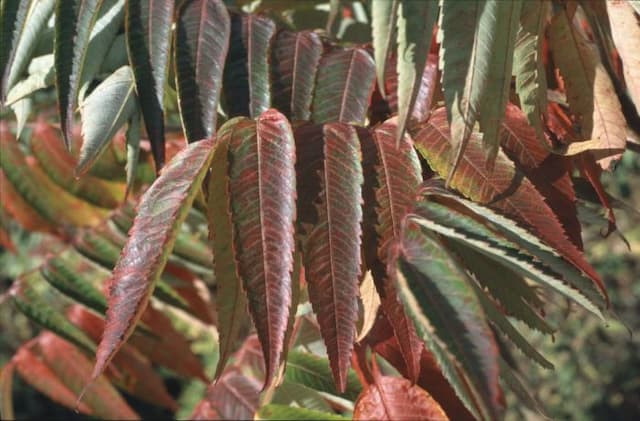
![Stag's horn sumach [Radiance]](/_next/image?url=https%3A%2F%2Fplants-admin.emdemapps.com%2Fimages%2Fplants%2F%2Fimages%2F604b6223f1c1d.png&w=640&q=75)
